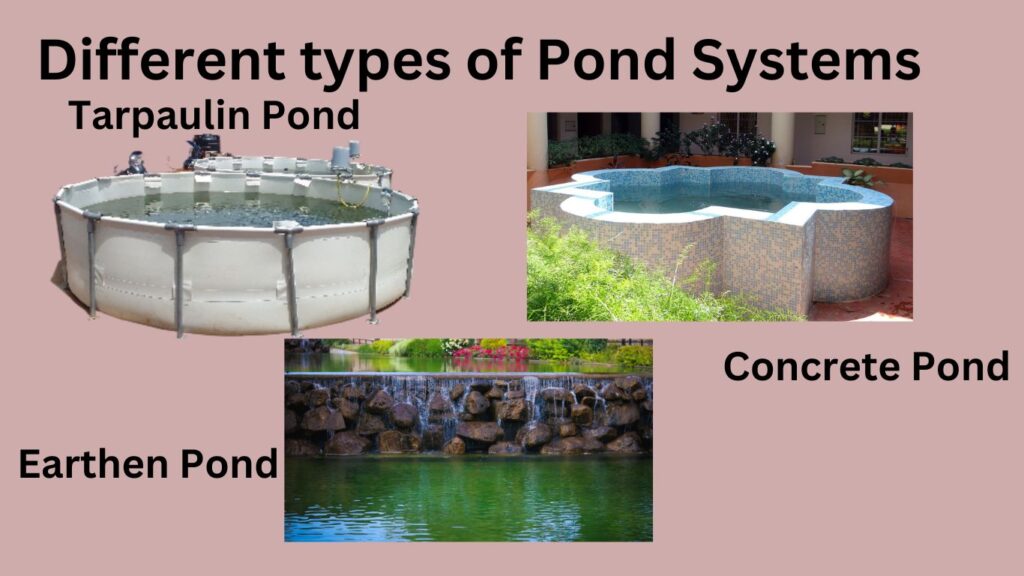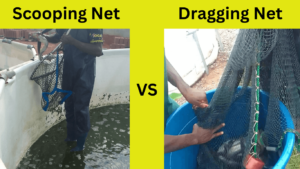Understanding the definitions and operational aspects of the methods of fish farming is important for selecting the most suitable approach based on your goals, available resources, and the local environment. Each method comes with its own set of advantages and challenges, so carefully consider the most suitable for you before making an informed decision.
Pond Aquaculture
Pond aquaculture involves the cultivation of fish in artificial or natural ponds. These ponds can vary in size and are typically filled with water to create a suitable environment for fish growth. The pond type could be plastic, tarpaulin, concrete, earthen, or any other created one.
Operation of Pond Aquaculture
– The pond is installed or constructed. The installation ones include Tarpaulin, Plastic, Concrete and other assembly materials. But for the Earth or concrete ones, we construct them.
– Fish are stocked in the pond.
– Natural or supplementary feeding is provided as a source of feed and protein.
– Regular monitoring of water quality is essential.
– Harvesting is done once the fish reach the desired size. And this depends on the market.
Advantage of Pond Aquaculture
Low Cost: Pond aquaculture is relatively inexpensive to set up compared to some other methods
Natural Habitat: Fish raised in ponds often have a habitat that reflect their natural environment.
Suitable for Various Species: Ponds can be used for farming a variety of fish species.
Disadvantages of Pond Aquaculture
Large Land Area Maybe Required: Requires a significant amount of land, which might not be feasible in densely populated or urban areas. But this also depends on the type you are setting up. A tarpaulin or plastic ones may require small space depending on how how you want it. But the earthen one requires a large space.
Disease Vulnerability: Ponds are subjected to diseases, and managing water quality is crucial to control disease control.

Image showing different types of Pond Aquaculture
Recirculating Aquaculture Systems (RAS)
RAS is a closed-loop system that reuses water by continuously filtering and recirculating it. This method aims to maintain optimal water conditions for fish through mechanical and biological filtration. The common ponds that can use RAS are Tarpaulin, Plastic, and Concrete.
Operations of Recirculating Aquaculture Systems (RAS)
– Water is circulated through tanks containing fish.
– Filtration systems remove waste and maintain water quality.
– Oxygen is often supplemented through aeration.
– Monitoring and control of parameters like temperature and pH are critical.
Advantages of RAS
Controlled Environment: Provides precise control over water quality parameters, enhancing fish growth.
Water Recycling: Reduces the need for large water bodies, making it suitable for areas with limited water resources since you will not have to constantly change the water.
Space Efficiency: RAS can be implemented in various locations, including urban settings.
Environmentally Friendly: in this system, since the water is constantly filtered, if you keep proper pond management, the farm will not be smelling. Therefore making it friendly for urban places where people live.
Disadvantages of RAS
High Initial Costs: Setting up a RAS facility can be expensive due to the technology and infrastructure involved. You need submersible Pumps, PVC pipes, containers, and other equipment. All these come at a cost
Energy Consumption: Requires continuous energy input for maintaining optimal conditions. The submersible water pumps cannot work without electricity.
Technical Expertise: Proper management demands knowledge of aquaculture and system maintenance. Seek an expert advice on RAS system.
Cage Culture
Cage culture involves confining fish in floating or submerged cages within natural water bodies, such as lakes, coastal areas, or rivers
Operation of Cage Culture
– Cages are placed in water bodies.
– Fish are stocked inside the cages.
– Feeding is done through the cage.
– Regular monitoring of fish health and water quality is necessary.
Advantages of Cage Culture
Utilizes Existing Water Bodies: Doesn’t require land as it utilizes natural water bodies like lakes or rivers.
Good Water Circulation: Constant water flow around cages ensures oxygen supply and waste removal.
Less Land Requirement: Suitable for areas where land availability is limited.
Adequate Water Supply: since the water changes automatically, you don’t always have to change water.
Disadvantages of Cage Culture
Risk of Escapes: Fish escaping from cages can have ecological and economic consequences.
Predator Vulnerability: Fish in cages may be more susceptible to predation since is difficult to control predators in such conditions
Water Pollution: Waste produced by fish can lead to localized water pollution because, the entire water body is floating through the cage, therefore, washing the waste of the fish to other parts of the water
Raceway Systems
Raceway systems consist of long channels or troughs with a continuous flow of water, providing a controlled environment for fish farming.
Operations of Raceway Systems
– Water flows through raceways, carrying fish along.
– Mechanical aeration ensures oxygen supply.
– Feeding is carefully managed.
– Regular maintenance and monitoring of water flow is essential.
Advantage of Raceway System
Controlled Water Flow: Provides a controlled environment with a consistent water flow.
Efficient Space Utilization: Fish are kept in channels, allowing for efficient use of space.
Suitable for Various Fish Species: Can accommodate different species with proper management
Disadvantages of Raceway System
Initial Setup Costs: Setting up raceway systems can be capital-intensive.
Energy Consumption: Requires energy for water circulation and aeration.
Maintenance Requirements: Regular maintenance is essential for optimal functioning
Integrated Multi-Trophic Aquaculture (IMTA):
IMTA is a sustainable farming approach that involves cultivating multiple species in proximity, where the by-products of one species are utilized as nutrients for another.
Operations of IMTA
– Different species are cultivated together.
– Waste from one species becomes nutrients for others.
– Requires careful management of species interactions.
– Aims for ecological balance and reduced environmental impact.
Advantages of IMTA
Waste Recycling: Utilizes the by-products of one species as nutrients for another, promoting sustainability.
Environmental Sustainability: Adopting natural ecosystems and reducing the environmental impact of aquaculture.
Diversification: Can cultivate multiple species in a single system, offering economic resilience.
Disadvantages of IMTA
Complex Management: Coordinating different species requires careful planning and management.
Species Compatibility: Not all species are compatible, and selecting suitable combinations is crucial.
Expertise Needed: Requires expertise in multiple species and their interactions.
Biofloc Technology (BFT)
Biofloc technology promotes the development of dense microbial communities in the water, creating an environment where microorganisms and suspended particles serve as a nutrient source for fish.
Operations of Biofloc Technology (BFT)
– Microorganisms form flocs that serve as a food source for fish.
– Water exchange is minimized.
– Aeration and proper management of microbial communities are crucial.
– Creates a closed-loop system with reduced environmental impact.
Advantage of BFT
Water Reuse: Utilizes a dense community of microorganisms to recycle nutrients, reducing water exchange.
Nutrient-Rich Environment: Creates a bioactive environment that can enhance fish health and growth.
Reduced Environmental Impact: Minimizes the environmental footprint of aquaculture operations.
Disadvantages of BFT
High Initial Investment Cost: Setting up BFT systems can be costly during the setup
Management Complexity: Requires careful monitoring of microbial communities and water quality.
Disease Outbreaks: Inadequate management can lead to disease outbreaks within the biofloc system.
Aquaponics
Aquaponics integrates fish farming (aquaculture) with soilless plant cultivation (hydroponics) in a vertical system where the waste produced by fish becomes nutrients for plants. The plants’ roots then also filter the fish waste and then introduce it back to the pond and the circle continues
Operations of Aquaponics
– Fish waste provides nutrients for plants.
– Water circulates between the fish tank and plant beds. In this case, you use one stone to kill two birds
– Plant roots filter and purify the water.
– Creates a symbiotic relationship between fish and plants in a vertical space.
Advantages of Aquaponics
Integration of Fish and Plants: Combines fish farming with hydroponics, creating a symbiotic relationship.
Efficient Space Utilization: Utilizes vertical space, making it suitable for urban environments.
Nutrient Recycling: Fish waste provides nutrients for plant growth, creating a closed-loop system.
High Produce: this means that you will be harvesting both fish and plants at the same setup
Disadvantages of Aquaponics
Technical Expertise Needed: Requires knowledge in both aquaculture and hydroponics.
High Initial Setup Costs: Setting up an aquaponics system can be relatively expensive. Setting up the fish pond on the one hand and setting up hydroponics too on the other hand require a lot of capital.
Energy Consumption: Requires energy for water circulation, aeration, and possibly lighting for plants. Submersible water pumps are required which consume electricity.
Conclusion
Whether you are a seasonal fish farmer or a beginner, you always have to consider several factors before putting up a fish farm. we have several methodologies of fish farming hence you need to select the one that best suits you. This means you consider factors such as geography, resource availability, your expertise, and others. But in all, fish farming is the best choice to ever make. So, start now.
You can also seek experts advice. Checkout the Best Aquaculture Experts now.




Hello! I could have sworn I’ve visited this website before but after looking at many of the posts I realized it’s new to me. Regardless, I’m certainly happy I came across it and I’ll be book-marking it and checking back often.
You’ve made some decent points there. I looked on the web for additional information about the issue and found most individuals will go along with your views on this site.
Spot on with this write-up, I really believe that this website needs much more attention. I’ll probably be back again to read through more, thanks for the advice.
Hello there, I discovered your site by the use of Google even as looking for a similar subject, your website came up, it looks good I have bookmarked it in my google bookmarks
Your point of view caught my eye and was very interesting. Thanks. I have a question for you.
Really good information can be found on web site.?
Awsome post and right to the point. I am not sure if
this is truly the best place to ask but do you folks have any ideea where to get some professional writers?
Thank you 🙂 Escape rooms
Attractive section of content. I just stumbled upon your site and in accession capital to assert
that I acquire in fact enjoyed account your blog posts. Anyway
I will be subscribing to your augment and even I achievement
you access consistently quickly.
You rocked this subject and have astounding insights. I also work hard in putting together great content about Tattoos, feel free to visit Seoranko
Hey, I enjoyed reading your posts! You have great ideas. Are you looking to get resources about Blogging or some new insights? If so, check out my website webemail24
Iam interested in starting my own fish farming although I have a small area may you please give me ideas
проститутки ижевска по удмуртской транс индивидуалки астрахани проститутки томска
снять секс геев в рязани
Hi, just wanted to mention, I loved this post.
It was inspiring. Keep on posting!
Thank you. I’m glad you like it
Heya i am for the first time here. I found this board and
I find It truly helpful & it helped me out much.
I am hoping to present one thing back and help others like you helped me.
Okay
Hi friends, its enormous piece of writing about educationand fully defined, keep it
up all the time.
Thank you